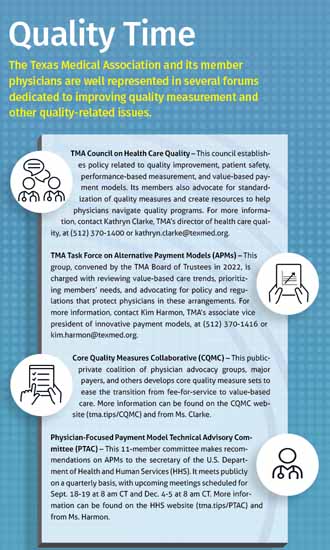
Austin family physician Norman Chenven, MD, is deeply familiar with the challenges quality measurements pose in practice.
For four decades, the founding CEO of Austin Regional Clinic and co-chair of the Texas Medical Association’s new Task Force on Alternative Payment Models (APMs) has worked within value-based care arrangements, dating back to HMOs in the early 1980s. Such arrangements pay physicians and other health care professionals based on the quality – rather than the quantity – of the services provided.
Value-based care hinges on quality measures to assess whether physicians and other health care professionals are, in fact, improving value, roughly defined as quality over costs. But measuring something as amorphous as quality is time-consuming, expensive, and often frustrating, underscoring physicians’ demands for reform, including standardization of quality measures.
In describing the challenge, Dr. Chenven recalls the U.S. Supreme Court’s 1964 decision in Jacobellis v. Ohio, which dealt with obscenity and First Amendment protections.
“I know quality when I see it,” he said.
Dr. Chenven can rattle off common physician grievances: Quality measures vary across health plans and require different reporting formats, sucking up practice resources. Measures often serve as proxies, connected in some “fuzzy” way to quality improvements but lacking clear evidence to this effect. Measures also fail to account for nonmedical factors that impact patient outcomes and may disincentivize physicians from taking on high-risk patients. (See “Quality of Life,” page 26.) And some worry that reporting certain blanket measures comes at the cost of individualized care.
In fact, participation in Medicare’s Merit-Based Incentive Payment System (MIPS) – a cornerstone of Medicare’s Quality Payment Program (QPP) – has fallen in recent years. Ninety percent of MIPS-eligible clinicians participated in the program in 2020, down from 97% in 2019, according to the most recent data from the Centers for Medicare & Medicaid Services (CMS).
This drop is likely due to the COVID-19 pandemic and related exemptions. But physicians also find the program cumbersome.
Weimar family physician Jorge Duchicela, MD, participates in MIPS as well as an accountable care organization. His three-physician practice has had to hire additional medical assistants to keep up with the quality reporting requirements for both, as well as for private payers, which use their own quality measures.
Dr. Duchicela worries this administrative burden falls especially hard on small and rural practices like his, which lack the scale to absorb additional work. He also wonders whether quality reporting requirements actually improve value – and if so, for whom?
“It’s a workload that requires human resources that we could use for different things,” he said. “We could be helping more patients. We have a present need.”
In a proactive effort to resolve these complaints, TMA and its member physicians are deeply involved in quality issues, from participating in the development of new measures to pushing payers for standardized quality programs and supporting physicians who are curious about value-based care. (See “Quality Time,” page 19.)
For instance, in 2020, TMA became the first state medical association to join the Core Quality Measures Collaborative (CQMC), which evaluates existing quality measures and decides whether to include them in a core set that, in the collaborative’s opinion, should be at the top of the list for inclusion in APMs.
Similarly, the U.S. comptroller general recently appointed two TMA nominees – Dallas internist Jim Walton, DO, and Houston family physician Lindsay Botsford, MD – to the 11-member Physician-Focused Payment Model Technical Advisory Committee (PTAC), which makes recommendations to the U.S. secretary of health and human services on APMs.
More recently, the TMA Board of Trustees approved the formation of the Task Force on APMs to help ease the transition from fee-for-service to value-based care. TMA leadership and staff also are in the process of meeting with each major payer to discuss quality concerns, administrative burdens, and payment delays that impact physicians’ ability to care for their patients.
There’s already evidence that such physician advocacy is having an impact.
CMS proposed in February its Universal Foundation initiative, which seeks to streamline quality measures across the agency’s quality-rating and value-based care programs. Doing so, CMS leadership wrote in the New England Journal of Medicine, could help alleviate administrative burdens on physicians and other health care professionals; mitigate health disparities; catalyze a shift to automated, digital reporting; and improve efficacy. The initiative also could ripple across the industry, as many private payers use CMS’ quality measures in their own value-based arrangements.
Although quality measures may seem like an intractable problem created by payers and health systems, Dr. Walton says it’s critical that physicians help develop sustainable solutions – or risk being excluded.
“One of the most important statements that can come from physicians is that we understand … how to approach quality improvement because we take care of patients, and many of us still run practices and understand the impact of health insurance cost inflation,” he said. “We have to own it.”
Austin family physician Ajay Gupta, MD, says physician involvement in the development of quality measures and of APMs – through channels such as CQMC and PTAC – eases their application and improves their utility down the line.
Dr. Gupta, who serves as chief medical officer for a payer and chairs TMA’s Council on Health Care Quality, empathizes with physicians.
“When I was in full-time practice, I would question, ‘Who came up with this [measure]?’” he said.
The Medicare Payment Advisory Commission (MedPAC), a congressional support agency that provides independent, nonpartisan advice on issues related to Medicare, raised similar concerns in a June 2018 report to Congress. MedPAC described Medicare’s quality measure programs as “overbuilt” and “relying on too many clinical process measures that are, at best, weakly correlated with health outcomes of importance to beneficiaries and the program.”
Dr. Gupta believes things have improved in recent years.
Since its founding in 2015, the core measures collaborative has involved more than 70 member organizations – which now include TMA, the American Medical Association, the American College of Physicians, America’s Health Insurance Plans, and the National Business Group on Health (now known as the Business Group on Health) – in the development of core quality measure sets.
This collaborative process means physicians often are familiar with and more trusting of the resulting measures, Dr. Gupta says.
“The discussion during those [CQMC] meetings has been really robust,” he said.
Still, there are challenges, including developing measures that directly relate to improved patient outcomes and lower costs on the same annual basis as physician payment – all while applying to various specialties.
Dr. Walton, who also serves on TMA’s Council on Health Care Quality, hopes PTAC can gain some traction in these areas.
The Medicare Access and CHIP Reauthorization Act (MACRA) established PTAC, alongside MIPS and several Medicare APMs, in 2015. The goal? To encourage physicians and other players to engage in the development of additional APMs. PTAC’s main responsibility is to review proposed APMs and then issue recommendations about them to the federal government.
Dr. Walton says PTAC’s strength derives from asking physicians how to improve quality of care, physician payment, and cost containment.
“The only way you know how to improve something is working in it today,” he said.
Because the U.S. secretary of health and human services has yet to adopt any of PTAC’s recommendations, the committee sometimes fields criticism, including from its own members. (See “Going Nowhere,” April 2020 Texas Medicine, pages 36-38.)
But Dr. Walton is sanguine. He says PTAC’s work may take several congressional cycles, given the scope of its mandate, to help shift Medicare from a fee-for-service payment model to a value-based one.
“To be successful, it will most likely feel like it was water pounding on a rock,” he said.
Dr. Botsford was drawn to PTAC by the idea of “physicians being part of the solution to the irrational payment system we have today.”
She also knows the impact physician involvement can have on APMs, citing her experience with Medicare’s direct-contracting and ACO Reach models.
“Both of those are examples of models where CMS took feedback directly from physicians,” she said. “You got to see how that close connection to physician groups on the ground led to models that really fundamentally transformed how primary care, in particular, is paid [for].”
Both Drs. Walton and Botsford are eager to engage Texas physicians with expertise in APMs or with ideas for their own APM proposals in PTAC’s work. (See “Quality Time,” page 19.)
“Our exposure to bright spots is only as wide as what we’re aware of,” Dr. Botsford said.

In addition to these efforts, TMA’s new Task Force on APMs is focused on ensuring insurers treat physicians fairly under value-based payment models, such as by expanding their options to include specialists.
The task force’s diverse membership – which spans specialties, experience levels, practice types, and geographic regions – is charged with reviewing value-based care trends, prioritizing members’ needs, and advocating for policy and regulations that protect physicians in these arrangements.
Dr. Chenven, the co-chair, anticipates this advocacy will include lobbying health plans to agree to a core set of quality measures, echoing TMA’s participation in the core measures collaborative and its agenda when meeting with insurers.
Although he admits a core set of measures isn’t a silver bullet, he says it would relieve physicians of significant administrative burden and guarantee they are being judged on an “apples to apples” basis “at least.”
In the meantime, other task force members, including Houston cardiologist George Basu, MD, are eager to usher fellow Texas physicians into the value-based fold.
Dr. Basu first became interested in value-based care in 2019, having been influenced by friends in the finance industry who were touting the benefits of quality payment programs.
“We wanted to be at the forefront of value-based care in cardiology, at least in Texas,” he said.
Today, his 16-physician, private group is focused on managing heart failure in a value-based care arrangement, aided in part by a new private equity group owner familiar with such payment models. Dr. Basu and his colleagues are measuring quality using two metrics: adherence to appropriate-use criteria, which aims to cut down on excessive imaging tests, and overall hospitalization numbers.
On the latter front, the group plans to pilot a same-day service at its clinic to encourage its patients with heart failure to access preventive care in house, rather than endure costly hospitalizations that often leave them feeling unmoored from their regular physician.
Although still in the works, Dr. Basu is thrilled at the potential upside, citing improved patient outcomes, patient satisfaction, and cost savings – especially since managing and treating cardiovascular disease account for roughly 15% of U.S. health care spending.
“If we save a lot in cardiology, we’ll impact the entire health care system,” he said.
Dr. Basu also is keen to evangelize his fellow specialists and subspecialists, who he says often have played second fiddle to their primary care counterparts in the rollout of APMs and other value-based care payment models. (See “Under Construction,” July 2022 Texas Medicine, pages 30-32.)
He adds many specialists, worried about the financial repercussions and the impact on patient outcomes of such models, need reassurance from peers who have paved a path forward.
“[TMA and the task force] are doing a great job communicating that the concept of moving from fee-for-service to value-based care shouldn’t be intimidating or concerning,” he said. “If you can have shared best practices, which is what TMA is having this task force do, then you’re going to guide the subspecialists along the way.”